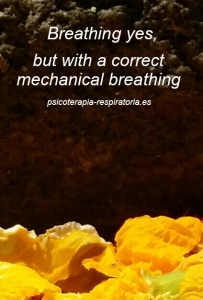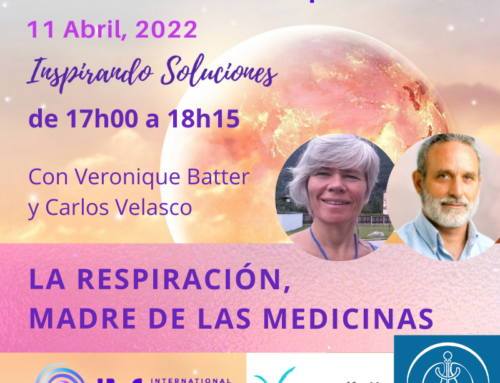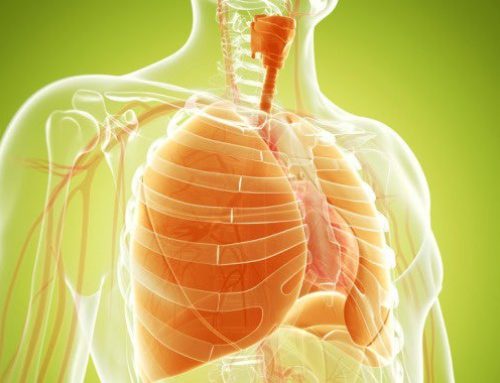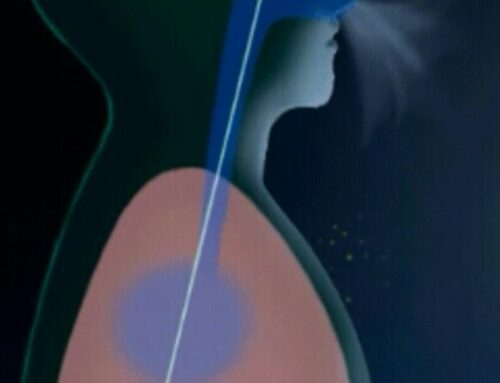 Breathing is certainly the key of life, offering multiple benefits, especially if one breathes correctly. It is necessary to breathe free from somatizations in order to breathe life much better. How can we do it? How is proper breathing biomechanics and why does it have to work according to what it has been designed for? There are dozens of advantages we can find in proper breathing.
Breathing is certainly the key of life, offering multiple benefits, especially if one breathes correctly. It is necessary to breathe free from somatizations in order to breathe life much better. How can we do it? How is proper breathing biomechanics and why does it have to work according to what it has been designed for? There are dozens of advantages we can find in proper breathing.
The better the mechanics of breathing, the greater will be the benefits. Breathing technics are practiced to achieve a specific goal, like in pranayama, Taoism, etc. A defective realization – wrong breathing mechanics – significantly reduces the obtained benefits, even causing, in certain cases, further problems. For example, for a person with a costoclavicular and “stomach in” breathing, stiffen throughout the years, certain techniques such as hyperventilation of lìkapalabhati are not recommended; if the belly was relaxed, the breathing mechanics would be more natural and the effects of this technique would be healthier.
The first breath that entered our lungs, after being born, was involuntary and natural. The breathing mechanics is designed to insert into the organism the quantity of oxygen necessary for any activity and situation. The body of the newborns is free from psycho-somatizations and, if there are any, they are unlikely to be blocking the ventilation mechanics. Babies tend to whole breathing, called yogi breathing, which expand within the three rings of the trunk – lumboabdominal, intercostal and cosoclavicular -, even though there is a ventral predominance.
It is wrong to say that we have to breathe abdominally like babies, without saying that the intercostal and costoclavicular rings expand as well. The breathing mechanics of the newborn has the capacity to expand the intercostal ribs, the sternum rises and the ribcage expands – it becomes wider. Think about it: in which part of the body are lungs located?
We were born with a proper functioning of the breathing pump. We didn’t learn how to breathe; breathing just happened in us. The breathing system is an essential part of an organism, which is designed to live in plenitude, accomplishing the homeostatic (auto-regulating) function, thanks to the wisdom of the body. Therefore, babies breathe in a natural way, according to the human “design”.
There is only one fundamentally right way to move the diaphragm and the musculature implied in breathing. Although there are different variations of the correct way, they are all based on the primordial function of the breathing mechanics. The fundamental breathing biomechanics is the same for any variation and in any circumstance. The accordion’s bellows have different positions depending on a fundamental trajectory A similar situation is the following: in a pot we can cook any type of food; the more you cook, the more you need to heat; then, the pressure would increase and there would be more vapor, but the pot would still be the same and the fundamental process of cooking, too. Another similar one: the cylinder and the piston of a car’s motor fundamentally work in the same way, the piston (diaphragm) moves within the cylinder (which is the trunk with its lumboabdominal and thoracic cavity). A car’s motor and the ventilation mechanics of the breathing system will activate approximately according to the necessities, but the cylinder and its piston – the trunk and its diaphragm – will keep on working the same way: going up and down. There are many types of motors and cars and there are many types of breathing systems, but motors essentially obey the same mechanics of functioning, the same breathing system. The diaphragm is the connection between the two trunk’s cavities – the abdominal and the thoracic -, whereas the latter works like an embolus.The diaphragm can go down up to about 12 cm. When the body is doing an intense activity or the diaphragm moves voluntarily, this muscle presses the organs of the belly producing a void, so that lungs can get full of air. Organs laying underneath the diaphragm will undergo the effects of compression and their blood will go back to the heart. The ribcage will expand due to this movement. By going up, the diaphragm will raise, getting a dome shape and the organs underneath the diaphragm will get full of arterial oxygenate blood – renewed blood, which will revive the organism.
The diaphragm in its contraction has to go down enough to the back hemidiaphragm. On top of it are located the lower lobuli of the lungs, which during the in-breath follow it in its itinerary, getting inserted into the costo-diaphragmatic cavity. The in-breath must be literally led to the point where the lumbar zone approximately begins, since the lower lobuli reach that point for the impulse of the back hemidiaphragm to go down. If the diaphragm is free and able to do the lowering and raising itinerary, overcoming the resistances of physical blocks, which are due to psychoemotional conflicts, the lungs will get full of air, according to the person’s necessities. At the same time, the three rings of the trunk – lumboabdominal, intercostal and costoclavicular – will expand properly. The mechanic wave is descending and expansive. The lumbar zone will expand. The energy accumulator, ming men or door of life, located between the second and third lumbar ribs will activate thanks to the great going down of the back part of the hemidiaphragm.
The hara or dan tien, life centre of the human being, whose deepest meaning is “to be able to be”, is located 4 cm under the belly bottom and centered in this ring. With an extension of almost one hand span, it will activate also thanks to the proper and optimal going down of the diaphragm.
This conscious and voluntary effort, based on a deep and real knowledge of the breathing mechanic, will make it possible that the a good habit will prevail over a wrong and toxic habit. In the process of going back to natural breathing, conscious voluntary mechanics will alternate with conscious involuntary or spontaneous breathing; the physical body and the awareness have recognized the freedom of expansion given by the freed mechanics of ventilation.
Gradually the effort invested in achieving a breathing mechanics in the lumbar zone will diminish in an involuntary way, inasmuch as musculature laying under and on the diaphragm is freed, reaching a proper tonic level.
In hatha yoga e other disciplines, postures – asanas – are done voluntarily and consciously. At first it implies more effort and fatigue, but after a while you will be able to do everything easily, softness will win against hardness. Involuntary breathing will be more correct in its original and natural form, getting to the point where “it breathes”, “I’m breathed”, “breathing dwells in me”, and “everything flows in me”. The eternal return to the original point, which is the natural breathing of babies, will be accomplished.
If you put one hand on the lumbar zone and the other one on the sternum, you should be able to feel that both hands expand during the in-breath. The more the lumbar zone expands, the more the chest expands, provided that the chest is sufficiently relaxed. The diaphragm can be blocked as well – it can’t make the necessary movement. In Taoism and Buddhism, as well as in other traditions, the lumbar zone always expands during the time of the in-breath. Could they be mistaken after thousands of years of experience? Certainly not. If the diaphragm has restrictions in its going down along the back zone, the lumbar zone will not expand.
How can we regain free breathing when the breathing biomechanics are physically and energetically blocked due to psycho-somatizations?
The Breathing Psychotherapy offers a diagnosis, psycho-diagnosis and treatment of the breathing mechanics. Almost everyone breathes slightly wrongly or in a totally wrong way; very few people have free breathing mechanics and breathe fully. We have to consider that in every body there are somatic traces of emotionally constrictive experiences. These “stigmata” hinder the functioning on the breathing pump.
If we try to dissolve them just by breathing without effort, it might be difficult to reduce those physical blocks, since the musculature is altered, some muscles are shortened and contracted – as it happened in a “sunken”, “imploded” chest – or a hyper/over-developed and hypertonic musculature – as it happens in an abdominal breathing of “ball-bellies”. Even gestures, postures, movement and the walking mechanics can be altered. Together with other “anti-natural” variables, they have blocked the free flow of breathing.
Bad habits. When breathing mechanics are blocked we can talk about years of “bunkerization”, where we can see a bad breathing habit caused by the block of ventilation biodynamics. It is difficult to reduce and eliminate this habit by simply “breathing without forcing” or without modifying anything.
Getting back to natural breathing, free from psycho-somatizations, just through the formula: “breathe naturally without forcing” is not easy at all, due to the inconvenient described above.
A certain school of yoga has given priority to abdominal breathing, deteriorating the full respiration or yogi breathing. The international school of yoga does not back this idea, because, even though the abdominal breathing has the least inconvenient, it is still an unnatural way; it is artificial and reduces the benefits of healthy breathing. It goes against full breathing.
Recovering breathing mechanics free from somatizations without considering the toxic codes, which have caused the breathing restrictions, the physical and energy blocks, the wrong breathing habits, posture, gestures, mobility, etc., is not easy at all. It can be proved in a great majority of different fields, which have tried to get back to natural and free breathing. This happens because they have not solved the above mentioned inconvenient, or they have come to respiration mechanics, which are consciously or unconsciously imposed and detach from the natural way. Therefore, some groups of people have a predominance of abdominal breathing whereas the chest expands slightly; other groups have a predominance of thoracic breathing with the stomach in, etc. We can easily observe these differences.
Isn’t it correct to try to bend our body as much as possible to the side like in the yoga posture “the half moon”, without exceeding the limits of self-protection? Then, why shouldn’t we sensibly force breathing when we know the functioning of its biomechanics?
We know that the lower lobuli alone can contain up to 60% of the in-breath air, and the hemi-diaphragm has to go down properly to obtain that. It we do it with a well-measured effort, similar to the act of bending a guitar’s string or an arch without breaking it, this measured and sensible effort is certainly profitable.




